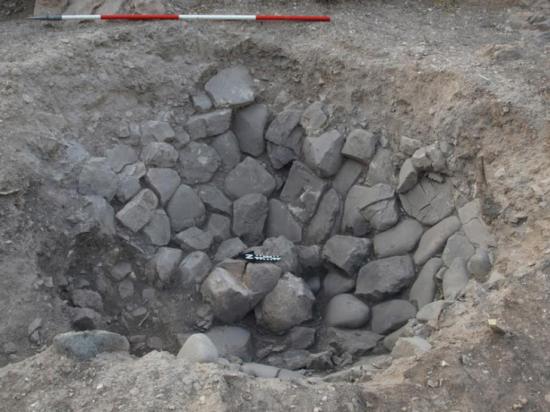Jean Christou
Source - http://cyprus-mail.com/2014/10/14/possible-prehistoric-barbeque-pit-discovered/?

Archaeologists have uncovered what could be a prehistoric barbeque pit used by large bands of hunters at the Prastio-Mesorotsos site in the Paphos district.
According to the antiquities department the team of archaeologists led by a University of Edinburgh professor, examined the prehistoric remains from the site, which was later settled during various other eras in antiquity.
It said the earliest deposits on the site dated to the Pre-Pottery Neolithic period – around 8000 BC to 7000 BC – and revealed storage pits and food preparation areas.
Two features from different areas of the site also revealed sophisticated pyrotechnology.
In one instance, a large stone-lined pit showed evidence of burning and was filled with a concentration of ash.
“If this feature was for roasting food, this pit-roast technique would have served the needs of a great number of people, possibly bands of hunters exploiting the upland resources,” said a statement from the antiquities department.
In another area, a smaller scale but roughly contemporary feature was an above-ground mud-built (pisé) domed structure similar to a tanour or kleftiko type oven. “This smaller domed oven could have been used for baking bread or roasting meat, but represents domestic-scale usage attesting to a diversity of activities,” it added.
Very close to the domed oven was an “enigmatic” series of shallow pits, at least 12 in total, that were cut into one another by the ancient inhabitants over a long period of time, from the Pre-pottery Neolithic to the Ceramic (Late) Neolithic phase of the site.
Many of these pits were filled deliberately with carefully-placed special objects, attesting occupational longevity and social memory of activity spaces. The antiquities department said the concentration of pits and the repeated use of them for disposing of unusual objects hinted at special behaviours and rituals.
Previous excavations at the site have revealed an extensive and complicated Bronze Age sequence of occupation complete with houses and work areas.
Major changes in artefacts and architecture showing the transition of the site from the Early (2400 BC) to Middle Cypriot Bronze Age (1900 BC-1600 BC) have also been noted.
The Middle Cypriot period was when the inhabitants began to intensify their lifestyle and social organisation. Massive construction had taken place just before the site was abandoned near the end of the Middle Cypriot period, not to be resettled again until after the Late Bronze Age (1300 BC-1200 BC), the Geometric (1050 BC-700 BC) and later periods.
This year’s excavations were conducted from June 9 to July 13. The team was led by Dr Andrew McCarthy, Fellow of the School of History, Classics and Archaeology at the University of Edinburgh, and Director of the Cyprus American Archaeological Research Institute (CAARI).